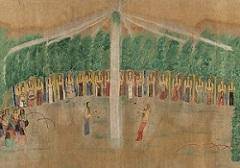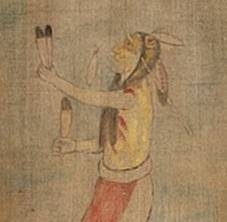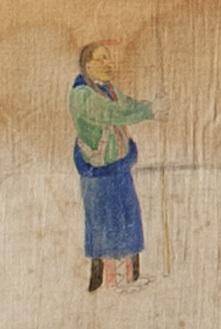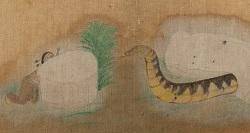Bring a piece of art to life with movement. Invite students to discover the world of Ute dance through Louis Fenno’s piece Painting of Bear and Sun Dances, and then get on their feet to choreograph their own animal dance.
Students will be able to:
- Decode a scene from a painting;
- Understand the importance of dances in Ute culture;
- Identify important elements of the Bear and Sun dances;
- Discuss the role of the bear in Ute culture; and
- Create dance moves based on the movements of various animals.
Lesson
- Warm-up: Display the image of Painting of Bear and Sun Dances and invite students to look carefully and share what they observe. Ask: What do you notice? What colors do you see in this painting? What adjectives would you use to describe this piece? Who do you think is going on in this image? What animals can you identify?
- Share with students that this painting, titled Painting of Bear and Sun Dances, was made by an artist named Louis Fenno sometime in the late 19th century. Fenno was a Ute Indian artist who was active during the late 1800s. He was hired or commissioned to paint these scenes of the Ute Bear Dance and Sun Dance by the owners of a trading post in Myton, in northwestern Utah. This painting shows two important dances of the Ute people in southern Colorado and Utah.
- Draw students’ attention to the top half of the painting, which depicts the Sun Dance. Ask: If you look closely, what do you notice about this dance? Does it look like there are a lot of people attending this ceremony? What stands out to you about the special structure built for this ceremony? Is everyone dancing or only some people? What else can we learn about this traditional dance from this image? Share with students that the Sun Dance, held each July, is both a personal quest by the dancers for spiritual power and purification and a communal rite. The dancers fast for the duration of the ceremony, which can last three or four days.
- Now, ask students to look closely at the lower half of the painting, which depicts the Bear Dance. Ask: How does the style of this dance differ from the dance shown in the top half of the painting? Is this a kind of dance that one does in a line or in a circle? This dance is called the Bear Dance and is a traditional ceremony that takes place in spring; what are bears doing in springtime? If you were to describe the personality of a bear, what would you say? Is it ferocious? Wise? Lazy? Do you think the dance music would have a fast beat or a slow beat? Why? Share with students that Ute Indians believe their ancestors were bears. They believe the bear is the wisest animal and possesses magical powers. This dance, with its loud drumming and singing is meant to awaken the bear, and he will then lead the people to gather roots, nuts and berries. In the painting, we see one line of male dancers (only their heads are visible) and one line of female dancers wearing shawls (we see their backs). The dance is performed by the women taking 3 steps forward and 3 steps back to the slow beat of the drum.
- Get your students up on their feet and gather them in a circle. Tell them they’ll work together to create a unique animal dance of their own. First, however, they need to think of some inspiring animals. Ask: What qualities do you think are important? Strength? Intelligence? Playfulness? Kindness? What kind of animals do you think could represent these qualities? How do these animals move? Create a list on the board of the qualities the class values and an animal to represent each. Next, assign a pair of students to each animal and have them create a movement to represent that animal. Give the pairs a few minutes to perfect their dance move and then gather the class together to perform the entire dance by mimicking each animal pair in turn.
Materials
- Large piece of chart paper and markers or (interactive) whiteboard on which to record students’ ideas as a class
- About the Art sheet on Painting of Bear and Sun Dances (found at the end of the lesson plan) or student access to this part of Creativity Resource online
- One color copy of the artwork for every four students, or the ability to project the image onto a wall or screen
Standards
- Social Studies
- Collaboration
- Critical Thinking & Reasoning
- Information Literacy
- Invention
- Self-Direction

Painting of Bear and Sun Dances
Height: 69.625 in. Width: 76.875 in.
Gift of C.W. Douglas, 1932.242
Photograph © Denver Art Museum 2012. All Rights Reserved.
For a long time, the name of the artist who created this painting wasn’t known. However, research by one of the museum’s Native Arts curators, Nancy Blomberg, uncovered about half a dozen paintings in other museums' collections that had a very similar style to this one. In the records associated with a painting almost exactly like this one, Blomberg found an entry in an auction catalog with a signature, and was therefore able to attribute this work to Louis Fenno.
Fenno was a Ute artist who was active during the late 1800s. He was hired, or commissioned, to paint these scenes of the Ute Bear Dance and Sun Dance by the owners of a trading post in Myton, in northwestern Utah.
This painting shows two important dances of the Ute people of southern Colorado and Utah. On the top is the Sun Dance that is held each July. The Sun Dance is both a personal quest by the dancers for spiritual power and purification and a communal rite for the entire tribe. The dancers fast for the duration of the ceremony, which can last three or four days.
The two lines of male and female dancers in the middle of the painting are performing the Bear Dance, one of the oldest Ute ceremonies, held in the spring when bears come out of hibernation. The Ute people believe their ancestors were bears. According to Ute tradition, the bear possesses magical powers and is the wisest animal. The Bear Dance is performed to awaken the bear from hibernation so the animal/ancestor can lead the people to gather roots, nuts, and berries.
Louis Fenno painted these scenes in great detail, portraying everything from the items of clothing worn by the dancers to the construction of the Sun Dance enclosure. His painting style is both individualistic and culturally accurate.
Details

Sun Dance Lodge
Fenno placed the Sun Dance lodge in the top center of the painting. Its center pole is meant to represent the center of power. The two dancers are closest to the pole, and family and community members watch from the edges of the brush circle. According to Southern Ute Sun Dance leader Eddie Box Sr., “the presence of family is absolutely critical in giving the Sun Dancer strength and sustenance as he undergoes his quest-ordeal.”

Sun Dance Fans
Some of the dancers carry eagle-feather fans.

Bear Dance Rasp
This man is rubbing a bear rasp, often made from an animal’s jawbone, to mimic the sound of the bear and create music and rhythm for the dance.

Seated Woman with Basket
On the left side of the painting, Fenno included a woman seated by herself, not participating in the dance. This woman probably represents the traditional practice of seclusion during menstruation.

Animals
Along the bottom of the image, Fenno painted an eagle, a snake emerging from an earthen mound, and a bighorn sheep entwined with a snake. Though we don’t know the meaning of these animal images, we believe they likely relate to the origins of the ceremonies shown in the artwork.
Funding for object education resources provided by a grant from the Morgridge Family Foundation. Additional funding provided by the William Randolph Hearst Endowment for Education Programs, and Xcel Energy Foundation. We thank our colleagues at the University of Denver Morgridge College of Education.
The images on this page are intended for classroom use only and may not be reproduced for other reasons without the permission of the Denver Art Museum. This object may not currently be on display at the museum.







